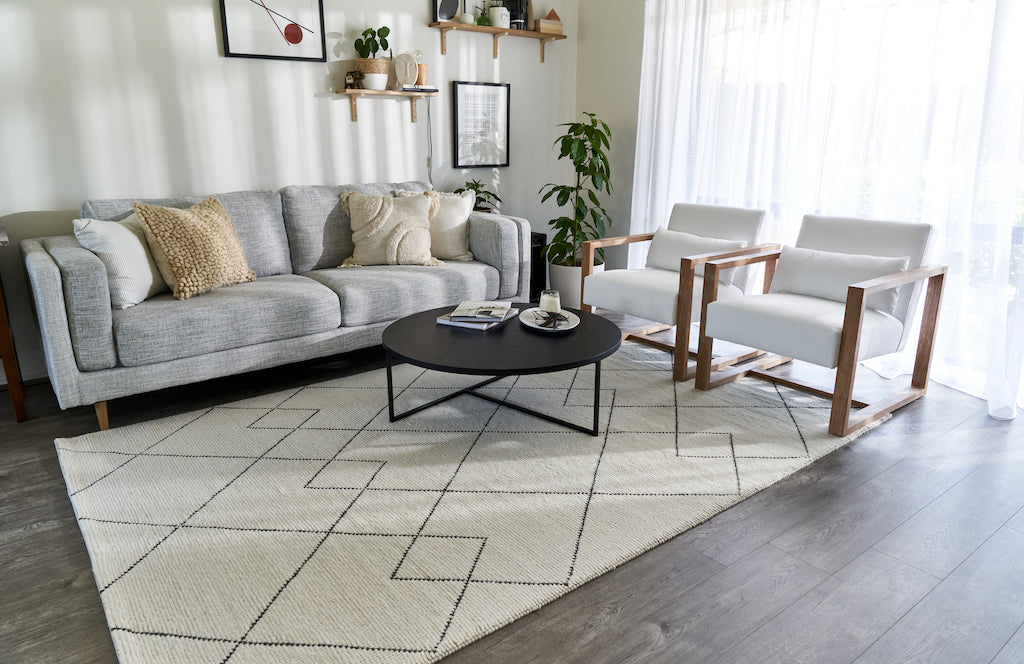
The Growing Popularity of Scandinavian Design Style Trends: What You Need to Know
Scandinavian design is an aesthetic known for its minimalism, functionality, and simplicity, characterised by clean lines, muted colours, and natural elements. This design style is popular in small living spaces and is eco-friendly and cost-effective, resonating with the current trend of sustainable living. Incorporating Scandinavian design principles into your home involves choosing a light and muted colour palette, high-quality and functional furniture pieces, and soft and warm lighting. This style can also be combined with other styles, such as industrial or mid-century modern, to achieve a modern-classic aesthetic.
Exploring Scandinavian Design
Defining Scandinavian Design
Scandinavian design is a unique and popular aesthetic that has gained worldwide recognition. Its minimalistic approach, functionality, and simplicity have made it a favourite among designers and homeowners alike. As a rug enthusiast or interior designer, you may be curious about the origins, defining features, and principles of this design style. Since its emergence in the mid-twentieth century, it has been best known and characterised by clean lines, muted colours, and simple forms. Scandinavian minimalism is all about functionality, with an emphasis on creating a comfortable and cosy living space.
The origins of Scandinavian design
The harsh and dark winters of the Nordic countries shaped the way people from those areas approached design. Because they needed functionality and comfort in their homes, they focused on creating furniture and decor that put a premium on simplicity and practicality. Influenced by the Bauhaus movement, Scandinavian designers embraced the concept of ‘form follows function’ with open arms and prioritised the needs of the homeowner.
Key principles
If there were only four words we could use to describe Scandinavian design, those words would be ‘minimalism’, ‘functionality’, ‘simplicity’, and ‘nature’. The design is all about creating a comfortable and cosy living space that is practical and functional. Natural elements like wood, stone, and leather often come into play to add warmth and texture. Muted colours such as white, grey, and beige are the go-to palette, but pops of vibrancy can be added for contrast.
💡KEY TAKEAWAY: Scandinavian design is a style that prioritises functionality and minimalism, characterised by its clean lines, muted colours, and simple forms. Incorporating Scandinavian design principles into your home can help you create a warm, inviting, and functional space that your family will love.
The Appeal of Scandinavian Design
Factors driving the design style’s popularity
One of the factors driving the popularity of Scandinavian design is how well-suited it is for small living spaces, which are all too common in urban areas. The clean lines and minimalistic approach to design make it easy to create a visually appealing space, even with limited square footage.
Additionally, Scandinavian design often makes use of natural textures and objects, a practice that resonates with the current trend of eco-friendliness while remaining cost-effective. Compared to more traditional, opulent, or intricate design styles, a Scandinavian minimalist aesthetic is significantly easier to achieve on a smaller budget.
The influence of technology
The multi-billion dollar tech industry is another reason Scandinavian minimalism is highly favoured. This is due to how well the design style aligns with the tech industry's ethos of simplicity and efficiency. Scandinavian design is often used in tech companies' offices and other modern workspaces, making it a popular choice for the design of today’s homes as well.
How sustainability aligns with minimalist design
The design style’s emphasis on natural materials allows those who want to pursue a sustainable lifestyle to streamline their home and minimise their carbon footprint. Its focus on functionality also means that it often incorporates features that promote energy efficiency, such as ample natural light and well-placed windows.
💡KEY TAKEAWAY: Scandinavian design's appeal lies in its simplicity, functionality, and elegance, making it a popular choice for modern living spaces. Its emphasis on eco-friendliness aligns well with the current trend of sustainable living. Its clean lines and functional approach resonate with the tech industry's ethos of simplicity and efficiency.
Incorporating Scandinavian Design into Your Home
Choosing a colour palette
There are a few key elements to keep in mind if you’re looking to achieve the minimalist, functional, and cosy aesthetic that defines Scandinavian design. One of the most important aspects is the colour palette. Stick to light and muted tones, such as whites, greys, and light blues, to create a calming and serene atmosphere. Accents of black can also be incorporated to add contrast and depth.
Selecting furniture pieces
In terms of furniture, you won’t go wrong with pieces that are simple, functional, and high-quality. Look for natural elements in the items you purchase for your space, such as wood and leather, and opt for streamlined and modern designs. The focus should be on comfort and practicality, rather than elaborate or ornate details.
Assessing lighting options
Lighting is another essential component of Scandinavian design. In this case, natural light should be maximised, so it’s best to keep window treatments minimal and let in as much light as possible. If certain spaces need a bit of a boost from artificial lighting, aim for soft and warm light to maintain that cosy and inviting atmosphere. Pendant lights, table lamps, and floor lamps are all great options.
When it comes to rugs, Scandinavian design typically favours simple and geometric patterns in muted tones. You can use a rug to define different areas in a room or to add texture and warmth to a space. Look for high-quality wool or cotton rugs that are soft and comfortable underfoot.
💡KEY TAKEAWAY: Incorporating Scandinavian design into your home is all about creating a calm and inviting atmosphere that puts function and simplicity above all else. For the best results, stick to a light and muted colour palette, choose functional and high-quality furniture pieces, focus on natural light and warm artificial lighting, and opt for simple and comfortable rugs that add texture and warmth to your space.
Combining Scandinavian Design with Other Styles
Mixing with industrial style
Mixing Scandinavian design with industrial style can give you a modern-classic aesthetic. You can transform your space by incorporating materials like raw wood, metal, and concrete. Use furniture with clean lines and simple shapes to maintain the Scandinavian feel, but add key industrial touches via statement lighting, exposed pipes, and metal accents. A minimalist colour palette with tasteful pops of colour can create a cohesive look.
Incorporating a bohemian aesthetic
Scandinavian design can provide some much-needed balance to the bohemian aesthetic by providing a sense of simplicity and order. Wood and woven textiles create a warm and inviting atmosphere, while the addition of Scandinavian furniture like mid-century chairs or sleek sofas can counter any vibrancy and multiple textures the room may feature. Use neutral colours as a base, then get creative by adding colourful and patterned textiles for a bohemian touch. Plants and natural elements, like rocks and shells, can bring the space into touch with nature and lend to that boho vibe.
Blending together with a minimalist approach
It’s no surprise that Scandinavian design and minimalism go hand-in-hand. Incorporate clean lines and simple shapes with a neutral colour palette for a chic look. The most important part? Be sure to avoid clutter and unnecessary decorations to keep the space easy on the eyes and the mind. Incorporate Scandinavian furniture such as functional shelving, sleek sofas, and minimalist lighting so that otherwise drab walls still have a focal point.
💡KEY TAKEAWAY: Combining Scandinavian design with other styles can create a unique and modern look. Mixing and matching with industrial, bohemian, or minimalist aesthetics can enhance the liveliness or tranquility of a space while also cleverly speaking to the homeowner’s personality. To get this look down pat, use simple shapes and neutral colour palettes to maintain the Scandinavian feel while incorporating elements of other styles.
The Future of Scandinavian Design
Emerging new trends
Scandinavian design has become synonymous with minimalism. However, new trends are emerging that are adding complexity and character to this iconic design style. One of those is the use of bold, colourful patterns and textures, which is a departure from the typical muted tones that have dominated Scandinavian design. This trend is particularly evident in the use of textiles, where designers are incorporating geometric shapes, organic patterns, and bold hues.
The future of sustainability
Designers are taking a more holistic approach to Scandinavian design, with a focus on creating products that are socially and ecologically responsible. This not only involves using sustainable materials and reducing waste but also creating products that are durable and long-lasting, minimising the need for disposal or repurchasing. The value of simplicity and functionality is now being combined with a commitment to sustainability.
The design style’s role in a post-pandemic world
With more people spending time at home, there was a renewed focus on creating spaces that are comfortable, functional, and aesthetically pleasing at the height of the pandemic. Scandinavian design is perfectly suited to this new reality, as it values ease and comfort. Designers are now creating products that are not only beautiful but also practical and comfortable, with a focus on creating spaces that promote relaxation and well-being.
💡KEY TAKEAWAY: Scandinavian design is evolving, with new trends emerging and a renewed focus on sustainability and comfort. Despite these changes, its core values of simplicity and functionality remain, ensuring its continued relevance in a post-pandemic world.
At Miss Amara, you'll discover a curated collection of high-quality rugs that can transform any space in your home. Our mission is to help you find the perfect rug that complements your unique style and personality and brings you a step closer to the home of your dreams.
















